Gorillas are the largest extant genus of primates. They are ground-dwelling, predominantly herbivorous apes that inhabit the forests of central Africa. Gorillas comprise one eponymous genus that is divided into two species and either four or five subspecies. The DNA of gorillas is highly similar to that of a human, from 95–99% depending on what is counted, and they are the next closest living relatives to humans after the bonobo and common chimpanzee.
Gorillas' natural habitats cover tropical or subtropical forests in Africa. Although their range covers a small percentage of Africa, gorillas cover a wide range of elevations. The mountain gorilla inhabits the Albertine Rift montane cloud forests of the Virunga Volcanoes, ranging in altitude from 2,200–4,300 metres (7,200–14,100 ft). Lowland gorillas live in dense forests and lowland swamps and marshes as low as sea level, with western lowland gorillas living in Central West African countries and eastern lowland gorillas living in the Democratic Republic of the Congo near its border with Rwanda.
Primatologists continue to explore the relationships between various gorilla populations. The species and subspecies listed here are the ones upon which most scientists agree.
The proposed third subspecies of Gorilla beringei, which has not yet received a trinomen, is the Bwindi population of the mountain gorilla, sometimes called the Bwindi gorilla.
Some variations that distinguish the classifications of gorilla include varying density, size, hair color, length, culture, and facial widths. There are now thought to be over 100,000 western lowland gorillas in the wild, with 4,000 in zoos; eastern lowland gorillas have a population of 4,000 in the wild and 24 in zoos. Mountain gorillas are the most severely endangered, with an estimated population of about 620 left in the wild and none in zoos.
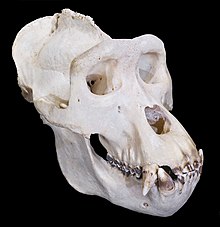 A skull of a gorilla
A skull of a gorilla
Gorillas move around by knuckle-walking, although they sometimes walk bipedally for short distances while carrying food or in defensive situations. Adult males, also called silverbacks, range in height 1.65–1.75 metres (5 ft 5 in–5 ft 9 in), and in weight 140–200 kg (310–440 lb). Adult females are often half the size of a silverback, averaging about 1.4 metres (4 ft 7 in) tall and 100 kg (220 lb). Occasionally, a silverback of over 1.8 metres (5 ft 11 in) and 230 kg (510 lb) has been recorded in the wild. Obese gorillas in captivity have reached a weight of 270 kg (600 lb). Gorillas have a facial structure which is described as mandibular prognathism, that is, their mandible protrudes farther out than the maxilla. Adult males also have a prominent sagittal crest.
The eastern gorilla is more darkly colored than the western gorilla, with the mountain gorilla being the darkest of all. The mountain gorilla also has the thickest hair. The western lowland gorilla can be brown or grayish with a reddish forehead. In addition, gorillas that live in lowland forests are more slender and agile than the more bulky mountain gorilla. The eastern gorilla also has a longer face and broader chest than the western gorilla.
Studies have shown that gorilla blood is non-reactive to anti-A and anti-B monoclonal antibodies which would, in humans, indicate type O blood. However, due to novel sequences it is different enough to not conform with the human ABO blood group system, which the other great apes fit into. Like humans, gorillas have individual finger prints. Their eye color is dark brown, framed by a black ring around the iris. Similar to humans, the leading cause of death in gorillas is cardiovascular disease.
 Young gorilla in tree
Young gorilla in tree
Gorillas have a patchy distribution. The range of the two species is separated by the Congo river and its tributaries.
The western gorilla lives in west central Africa while the eastern
gorilla lives in east central Africa. Between the species and even
within the species, gorillas live in a variety of habitats and
elevations. Gorilla habitat ranges from montane forests to swamps. Eastern gorilla inhabit montane and submontane forests between 650–4000 m (2132-13,123 ft).
Mountain gorillas live in the montane forests at the higher ends of the
elevation range while eastern lowland gorillas live in submotane
forests at the lower ends of the elevation range. In addition, eastern
lowland gorillas live in montane bamboo forests as well as lowland
forests ranging from 600–3308 m (1969-10,853 ft) in elevation.
Western gorillas live in both lowland swamp forests and montane forests
and live in elevations ranging from sea level to 1600 m (5249 ft).
Western lowland gorillas live in swamp and lowland forests ranging up
to 1600 m (5249 ft) and Cross River gorillas live in low-lying and
submontane forests ranging 150–1600 m (492–5249 ft).
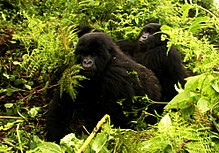 Gorillas moving in habitat
Gorillas moving in habitat

Gorilla foraging
A gorilla's day is synchronized, divided between rest periods and
travel or feeding periods. There are dietary differences between and
within species. Mountain gorillas mostly eat foliage such as leaves,
stems, pith, and shoots while fruit makes up a very small part of their
diet. They primarily eat bamboo.
The food that mountain gorillas eat is widely distributed and both
individuals and groups do not have to compete with each other. Their
home ranges average 3–15 km2 (1.16–5.79 mi2), and their movements range around 500 m (0.311 mi) or less on an average day. Despite eating a few species in each habitat, mountain gorillas have a flexible diet and can live in a variety of habitats.
Eastern lowland gorillas have a more diverse diet which varies seasonally. Leaves and pith are commonly eaten but fruits can make up as much as 25% of their diet. Since fruit is less available, lowland gorillas must travel farther each day and have home ranges that vary from 2.7–6.5 km2 (1.04 to 2.51 mi2) with day ranges 154–2280 m (0.096–1.42 mi). Eastern lowland gorillas will also eat insects, preferably ants. Western lowland gorillas depend on fruits more than the others and they are more dispersed across their range. They travel even further than the other gorilla subspecies, at 1105 m (0.687 mi) per day on average, and have larger home ranges of 7–14 km2 (2.70–5.41 mi2). Western lowland gorillas have less access to terrestrial herbs, although they can access aquatic herbs in some areas. Termites and ants also are also eaten.
Gorillas rarely drink water "because they consume succulent vegetation that is comprised of almost half water as well as morning dew", although both mountain and lowland gorillas have been observed drinking.
One possible predator of gorillas is the leopard. Gorilla remains have been found in leopard scat but it is possible that this may be the result of scavenging. When the group is attacked by humans, leopards, or other gorillas, an individual silverback will protect the group, even at the cost of his own life. George Schaller reported that a "silverback gorilla and a leopard were both found dead from mutually inflicted wounds".
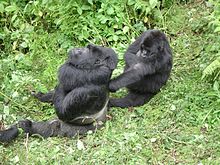 Silverback gorilla with one of his females
Silverback gorilla with one of his females
Gorillas live in groups called troops. Troops tend to be made of one
adult male or silverback, multiple adult females and their offspring. However, multi-male troops also exist.
Silverbacks are typically more than 12 years of age and named for the
distinctive patch of silver hair on their back which comes with
maturity. They also have large canine teeth which also come with
maturity. Both males and females tend to emigrate from their natal
groups. For mountain gorillas, females disperse from their natal troops
more than males. Mountain gorillas and western lowland gorillas also commonly transfer to second new groups.
Mature males tend to also leave their groups and establish their own
troops by attracting emigrating females. However, male mountain gorillas
sometimes stay in their natal troops and become subordinate to the
silverback. If the silverback dies, these males may be able to become
dominant or mate with the females. This behavior has not been observed
in eastern lowland gorillas. In a single male group, when the silverback
dies, the females and their offspring disperse and find a new troop. Without a silverback to protect them, the infants will likely fall victim to infanticide. Joining a new group is likely to be a tactic against this.
However while gorilla troops usually disband after the silverback dies,
female eastern lowlands gorillas and their offspring have been recorded
staying together until a new silverback transfers into the group. This
likely serves as protection from leopards. All male troops have also been recorded.
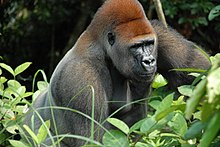 Silverback gorilla
Silverback gorilla
The silverback is the center of the troop's attention, making all the decisions, mediating conflicts, determining the movements of the group, leading the others to feeding sites and taking responsibility for the safety and well-being of the troop. Younger males subordinate to the silverback, known as blackbacks, may serve as backup protection. Blackbacks are aged between 8 and 12 years of age and lack the silver back hair. The bond a silverback has with his females forms the core of gorilla social life. Bonds between them are maintained by grooming and stay close together. Females form strong relationships with males to gain mating opportunities and protection from predators and infanticidal outside males. However aggressive behaviors between males and females do occur but rarely lead to serious injury. Relationships between females may vary. Maternally related females in a troop tend to be friendly towards each other and associate closely. Otherwise, females have few friendly encounters and commonly act aggressively towards each other. Females may fight for social access to males and a male may intervene. Male gorillas have weak social bonds, particularly in multi-male groups with apparent dominance hierarchies and strong competition for mates. However, males in all-male groups tend to have friendly interactions and socialize through play, grooming and staying together, and occasionally they even engage in homosexual interactions.
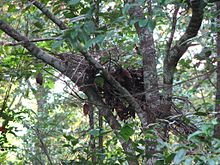 Gorilla night nest constructed in a tree.
Gorilla night nest constructed in a tree.
Gorillas construct nests for daytime and night use. Nests tend to be simple aggregations of branches and leaves about 2 to 5 feet (0.61 to 1.5 m) in diameter and are constructed by individuals. Gorillas, unlike chimpanzees or orangutans, tend to sleep in nests on the ground. The young nest with the mother but construct nests after three years of age, initially close to that of their mother. Gorilla nests are distributed arbitrarily and use of tree species for site and construction appears to be opportunistic. Nest building by great apes is now considered to be not just animal architecture but as an important instance of tool use.
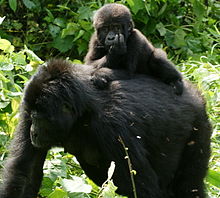
Females mature at 10–12 years (earlier in captivity); males at 11–13 years. A female’s first ovulatory cycle occurs when she is six years of age and is followed by a two year long period of adolescent infertility. The estrous cycle last 30–33 days with outward ovulation signs subtle compared to that of chimpanzees. The gestation period lasts 8.5 months. Female mountain gorillas first give birth at 10 years of age and have four year interbirth intervals. Males can be fertile before reaching adulthood. Gorillas mate year round.
Females will purse their lips and slowly approach a male while and make eye contact. This serves to urge the male to mount her. If the male does not respond, then she will try to attract his attention by reaching towards him or slapping the ground. In multi-male groups, solicitation indicates female preference. However females can be forced to mate with multiple males. Males incite copulation by approaching a female and displaying at her or touching her and giving a "train grunt". Recently, gorillas have been observed engaging in face-to-face sex, a trait that was once considered unique to humans and the bonobo.
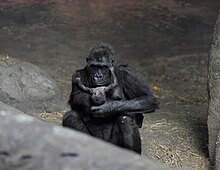 Mother gorilla with 10-day-old infant
Mother gorilla with 10-day-old infant
Gorilla infants are vulnerable and dependant and thus mothers, their primary caregivers, are important to their survival. Male gorillas are not active in caring for the young. However they do play a role in socializing them to other youngsters. The silverback has a largely supportive relationship with the infants in his troop and shields them from aggression within the group. Infants remain in contact with their mothers for the first five months and mothers stay near the silverback for protection. Infants will suckle at least once per hour and will sleep with their mothers in the same nest.
Infants begin to break contact with their mothers after five months but only for brief period each time. By 12 months, infants move up to five meters (16.4 ft) from their mothers. At around 18–21 months, the distance between mother and offspring increases and they regularly spend time away from each other. In addition, nursing decreases to once every two hours. Infants spend only half of their time with their mothers by 30 months. They enter their juvenile period at their third year and this lasts until their sixth year. At this time, gorillas are weaned and they sleep in a separate nest from their mothers. After their offspring are weaned, females begin to ovulate and soon become pregnant again. The presence of play partners, including the silverback, minimize conflicts in weaning between mother and offspring.
A gorilla's lifespan is between 35–40 years, although zoo gorillas may live for 50 years and more. Dallas Zoo's Jenny was the oldest living gorilla in captivity until 2008 when she died at the age of 55. Now it is Colo - on December 22, 2011 she celebrated her 55th birthday in Columbus Zoo.
Twenty-five distinct vocalizations
are recognized, many of which are used primarily for group
communication within dense vegetation. Sounds classified as grunts and
barks are heard most frequently while traveling, and indicate the
whereabouts of individual group members.
They may also be used during social interactions when discipline is
required. Screams and roars signal alarm or warning, and are produced
most often by silverbacks. Deep, rumbling belches suggest contentment
and are heard frequently during feeding and resting periods. They are
the most common form of intragroup communication. Severe aggression
is rare in stable groups, but when two mountain gorilla groups meet,
the two silverbacks can sometimes engage in a fight to the death, using
their canines to cause deep, gaping injuries.
The entire sequence has nine steps: (1) progressively quickening
hooting, (2) symbolic feeding, (3) rising bipedally, (4) throwing
vegetation, (5) chest-beating with cupped hands, (6) one leg kick, (7)
sideways running, two-legged to four-legged, (8) slapping and tearing
vegetation, and (9) thumping the ground with palms to end display.
Gorillas are considered highly intelligent. A few individuals in captivity, such as Koko, have been taught a subset of sign language. Like the other great apes, gorillas can laugh, grieve, have "rich emotional lives," develop strong family bonds, can make and use tools, and can think about the past and future. Some researchers believe that gorillas have spiritual feelings or religious sentiments. Gorillas have been shown to have cultures in different areas revolving around different methods of food preparation, and gorillas will show individual color preferences.
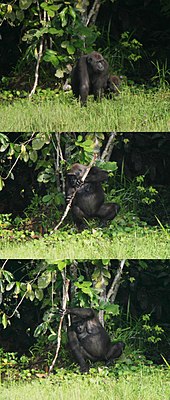 A female gorilla exhibiting tool use by using a tree trunk as a support whilst fishing herbs.
A female gorilla exhibiting tool use by using a tree trunk as a support whilst fishing herbs.
The following observations were made by a team led by Thomas Breuer of the Wildlife Conservation Society in September 2005. Gorillas are now known to use tools in the wild. A female gorilla in the Nouabalé-Ndoki National Park in the Republic of Congo was recorded using a stick as if to gauge the depth of water whilst crossing a swamp. A second female was seen using a tree stump as a bridge and also as a support whilst fishing in the swamp. This means that all of the great apes are now known to use tools.
In September 2005, a two and a half year old gorilla in the Republic of Congo was discovered using rocks to smash open palm nuts inside a game sanctuary. While this was the first such observation for a gorilla, over 40 years previously chimpanzees had been seen using tools in the wild 'fishing' for termites. Great apes are endowed with a semi-precision grip, and have been able to use both simple tools and even weapons, by improvising a club from a convenient fallen branch.
The word "gorilla" comes from the history of Hanno the Navigator, a Carthaginian explorer on an expedition on the west African
coast. They encountered "a savage people, the greater part of whom were
women, whose bodies were hairy, and who our interpreters called
Gorillae". The word was then later used as the species name, though it is unknown whether what these ancient Carthaginians encountered were truly gorillas, another species of ape or monkeys, or humans.
American physician and missionary Thomas Staughton Savage obtained the first specimens (the skull and other bones) during his time in Liberia in Africa. The first scientific description of gorillas dates back to an article by Savage and the naturalist Jeffries Wyman in 1847 in Proceedings of the Boston Society of Natural History, where Troglodytes gorilla is described, now known as the Western Gorilla. Other species of gorilla are described in the next couple of years.
Explorer Paul du Chaillu was the first westerner to see a live gorilla during his travel through western equatorial Africa from 1856 to 1859. He brought dead specimens to the UK in 1861.
The first systematic study was not conducted until the 1920s, when Carl Akeley of the American Museum of Natural History traveled to Africa to hunt for an animal to be shot and stuffed. On his first trip he was accompanied by his friends Mary Bradley, a mystery writer, and her husband. After their trip, Mary Bradley wrote On the Gorilla Trail. She later became an advocate for the conservation of gorillas and wrote several more books (mainly for children). In the late 1920s and early 1930s, Robert Yerkes and his wife Ava helped further the study of gorillas when they sent Harold Bigham to Africa. Yerkes also wrote a book in 1929 about the great apes.
 Drawing of French explorer Paul du Chaillu at close quarters with a gorilla
Drawing of French explorer Paul du Chaillu at close quarters with a gorilla
After World War II, George Schaller was one of the first researchers to go into the field and study primates. In 1959, he conducted a systematic study of the mountain gorilla in the wild and published his work. Years later, at the behest of Louis Leakey and the National Geographic, Dian Fossey conducted a much longer and more comprehensive study of the mountain gorilla. It was not until she published her work that many misconceptions and myths about gorillas were finally disproved, including the myth that gorillas are violent.
The eastern gorilla is listed as endangered on the IUCN Red List, with the mountain gorilla listed as Critically Endangered. The western gorilla and its subspecies are also listed as Critically Endangered. Threats to gorilla survival include habitat destruction and poaching for the bushmeat trade. In 2004, a population of several hundred gorillas in the Odzala National Park, Republic of Congo was essentially wiped out by the Ebola virus. A 2006 study published in Science
concluded that more than 5,000 gorillas may have died in recent
outbreaks of the Ebola virus in central Africa. The researchers
indicated that in conjunction with commercial hunting of these apes, the
virus creates "a recipe for rapid ecological extinction." Conservation efforts include the Great Ape Survival Project, a partnership between the United Nations Environment Programme and the UNESCO, and also an international treaty, the Agreement on the Conservation of Gorillas and Their Habitats, concluded under UNEP-administered Convention on Migratory Species. The Gorilla Agreement is the first legally binding instrument exclusively targeting Gorilla conservation and came into effect on 1 June 2008.
The gorilla became the next last great ape genus to have its genome
sequenced. This has given scientists further insight into the evolution
and origin of humans. Despite the chimpanzees being the closest extant
relatives of humans, it was found that 15% of the human genome is more
like that of the gorilla.
In addition 30% of the gorilla genome "is closer to human or chimpanzee
than the latter are to each other; this is rarer around coding genes,
indicating pervasive selection throughout great ape evolution, and has
functional consequences in gene expression."
Analysis of the gorilla genome has cast doubt on the idea that the
rapid evolution of hearing genes gave rise to language in humans as it
also occurred in gorillas.
Since they came to the attention of western society in the 1860s, gorillas have been a recurring element of many aspects of popular culture and media. For example, gorillas have featured prominently in monstrous fantasy films such as King Kong, and pulp fiction such as the stories of Tarzan and Conan the Barbarian have featured gorillas as physical opponents to the titular protagonists.
Gorillas' natural habitats cover tropical or subtropical forests in Africa. Although their range covers a small percentage of Africa, gorillas cover a wide range of elevations. The mountain gorilla inhabits the Albertine Rift montane cloud forests of the Virunga Volcanoes, ranging in altitude from 2,200–4,300 metres (7,200–14,100 ft). Lowland gorillas live in dense forests and lowland swamps and marshes as low as sea level, with western lowland gorillas living in Central West African countries and eastern lowland gorillas living in the Democratic Republic of the Congo near its border with Rwanda.
Etymology
The American physician and missionary Thomas Staughton Savage and naturalist Jeffries Wyman first described the western gorilla (they called it Troglodytes gorilla) in 1847 from specimens obtained in Liberia. The name was derived from Greek Γόριλλαι (Gorillai), meaning "tribe of hairy women", described by Hanno the Navigator, a Carthaginian navigator and possible visitor (circa 480 BC) to the area that later became Sierra Leone.
Evolution and classification
The closest relatives of gorillas are chimpanzees and humans, all of the Hominidae having diverged from a common ancestor about 7 million years ago. Human genes differ only 1.6% on average from their corresponding gorilla genes in their sequence, but there is further difference in how many copies each gene has. Until recently there was considered to be a single gorilla species, with three subspecies: the western lowland gorilla, the eastern lowland gorilla and the mountain gorilla. There is now agreement that there are two species with two subspecies each. More recently it has been claimed that a third subspecies exists in one of the species. The separate species and subspecies developed from a single type of gorilla during the Ice Age, when their forest habitats shrank and became isolated from each other.
Primatologists continue to explore the relationships between various gorilla populations. The species and subspecies listed here are the ones upon which most scientists agree.
| Taxonomy of genus Gorilla[1] | Phylogeny of superfamily Hominoidea | |||||||||||||||||||||||||||
|---|---|---|---|---|---|---|---|---|---|---|---|---|---|---|---|---|---|---|---|---|---|---|---|---|---|---|---|---|
|
|
Some variations that distinguish the classifications of gorilla include varying density, size, hair color, length, culture, and facial widths. There are now thought to be over 100,000 western lowland gorillas in the wild, with 4,000 in zoos; eastern lowland gorillas have a population of 4,000 in the wild and 24 in zoos. Mountain gorillas are the most severely endangered, with an estimated population of about 620 left in the wild and none in zoos.
Physical characteristics

Gorillas move around by knuckle-walking, although they sometimes walk bipedally for short distances while carrying food or in defensive situations. Adult males, also called silverbacks, range in height 1.65–1.75 metres (5 ft 5 in–5 ft 9 in), and in weight 140–200 kg (310–440 lb). Adult females are often half the size of a silverback, averaging about 1.4 metres (4 ft 7 in) tall and 100 kg (220 lb). Occasionally, a silverback of over 1.8 metres (5 ft 11 in) and 230 kg (510 lb) has been recorded in the wild. Obese gorillas in captivity have reached a weight of 270 kg (600 lb). Gorillas have a facial structure which is described as mandibular prognathism, that is, their mandible protrudes farther out than the maxilla. Adult males also have a prominent sagittal crest.
The eastern gorilla is more darkly colored than the western gorilla, with the mountain gorilla being the darkest of all. The mountain gorilla also has the thickest hair. The western lowland gorilla can be brown or grayish with a reddish forehead. In addition, gorillas that live in lowland forests are more slender and agile than the more bulky mountain gorilla. The eastern gorilla also has a longer face and broader chest than the western gorilla.
Studies have shown that gorilla blood is non-reactive to anti-A and anti-B monoclonal antibodies which would, in humans, indicate type O blood. However, due to novel sequences it is different enough to not conform with the human ABO blood group system, which the other great apes fit into. Like humans, gorillas have individual finger prints. Their eye color is dark brown, framed by a black ring around the iris. Similar to humans, the leading cause of death in gorillas is cardiovascular disease.
Behavior and ecology

Range and habitat
Food and foraging


Eastern lowland gorillas have a more diverse diet which varies seasonally. Leaves and pith are commonly eaten but fruits can make up as much as 25% of their diet. Since fruit is less available, lowland gorillas must travel farther each day and have home ranges that vary from 2.7–6.5 km2 (1.04 to 2.51 mi2) with day ranges 154–2280 m (0.096–1.42 mi). Eastern lowland gorillas will also eat insects, preferably ants. Western lowland gorillas depend on fruits more than the others and they are more dispersed across their range. They travel even further than the other gorilla subspecies, at 1105 m (0.687 mi) per day on average, and have larger home ranges of 7–14 km2 (2.70–5.41 mi2). Western lowland gorillas have less access to terrestrial herbs, although they can access aquatic herbs in some areas. Termites and ants also are also eaten.
Gorillas rarely drink water "because they consume succulent vegetation that is comprised of almost half water as well as morning dew", although both mountain and lowland gorillas have been observed drinking.
One possible predator of gorillas is the leopard. Gorilla remains have been found in leopard scat but it is possible that this may be the result of scavenging. When the group is attacked by humans, leopards, or other gorillas, an individual silverback will protect the group, even at the cost of his own life. George Schaller reported that a "silverback gorilla and a leopard were both found dead from mutually inflicted wounds".
Social structure


The silverback is the center of the troop's attention, making all the decisions, mediating conflicts, determining the movements of the group, leading the others to feeding sites and taking responsibility for the safety and well-being of the troop. Younger males subordinate to the silverback, known as blackbacks, may serve as backup protection. Blackbacks are aged between 8 and 12 years of age and lack the silver back hair. The bond a silverback has with his females forms the core of gorilla social life. Bonds between them are maintained by grooming and stay close together. Females form strong relationships with males to gain mating opportunities and protection from predators and infanticidal outside males. However aggressive behaviors between males and females do occur but rarely lead to serious injury. Relationships between females may vary. Maternally related females in a troop tend to be friendly towards each other and associate closely. Otherwise, females have few friendly encounters and commonly act aggressively towards each other. Females may fight for social access to males and a male may intervene. Male gorillas have weak social bonds, particularly in multi-male groups with apparent dominance hierarchies and strong competition for mates. However, males in all-male groups tend to have friendly interactions and socialize through play, grooming and staying together, and occasionally they even engage in homosexual interactions.
Nesting

Gorillas construct nests for daytime and night use. Nests tend to be simple aggregations of branches and leaves about 2 to 5 feet (0.61 to 1.5 m) in diameter and are constructed by individuals. Gorillas, unlike chimpanzees or orangutans, tend to sleep in nests on the ground. The young nest with the mother but construct nests after three years of age, initially close to that of their mother. Gorilla nests are distributed arbitrarily and use of tree species for site and construction appears to be opportunistic. Nest building by great apes is now considered to be not just animal architecture but as an important instance of tool use.
Reproduction and parenting

Young gorilla riding on mother
Females mature at 10–12 years (earlier in captivity); males at 11–13 years. A female’s first ovulatory cycle occurs when she is six years of age and is followed by a two year long period of adolescent infertility. The estrous cycle last 30–33 days with outward ovulation signs subtle compared to that of chimpanzees. The gestation period lasts 8.5 months. Female mountain gorillas first give birth at 10 years of age and have four year interbirth intervals. Males can be fertile before reaching adulthood. Gorillas mate year round.
Females will purse their lips and slowly approach a male while and make eye contact. This serves to urge the male to mount her. If the male does not respond, then she will try to attract his attention by reaching towards him or slapping the ground. In multi-male groups, solicitation indicates female preference. However females can be forced to mate with multiple males. Males incite copulation by approaching a female and displaying at her or touching her and giving a "train grunt". Recently, gorillas have been observed engaging in face-to-face sex, a trait that was once considered unique to humans and the bonobo.

Gorilla infants are vulnerable and dependant and thus mothers, their primary caregivers, are important to their survival. Male gorillas are not active in caring for the young. However they do play a role in socializing them to other youngsters. The silverback has a largely supportive relationship with the infants in his troop and shields them from aggression within the group. Infants remain in contact with their mothers for the first five months and mothers stay near the silverback for protection. Infants will suckle at least once per hour and will sleep with their mothers in the same nest.
Infants begin to break contact with their mothers after five months but only for brief period each time. By 12 months, infants move up to five meters (16.4 ft) from their mothers. At around 18–21 months, the distance between mother and offspring increases and they regularly spend time away from each other. In addition, nursing decreases to once every two hours. Infants spend only half of their time with their mothers by 30 months. They enter their juvenile period at their third year and this lasts until their sixth year. At this time, gorillas are weaned and they sleep in a separate nest from their mothers. After their offspring are weaned, females begin to ovulate and soon become pregnant again. The presence of play partners, including the silverback, minimize conflicts in weaning between mother and offspring.
Lifespan
Communication
Intelligence
Gorillas are considered highly intelligent. A few individuals in captivity, such as Koko, have been taught a subset of sign language. Like the other great apes, gorillas can laugh, grieve, have "rich emotional lives," develop strong family bonds, can make and use tools, and can think about the past and future. Some researchers believe that gorillas have spiritual feelings or religious sentiments. Gorillas have been shown to have cultures in different areas revolving around different methods of food preparation, and gorillas will show individual color preferences.
Tool use

The following observations were made by a team led by Thomas Breuer of the Wildlife Conservation Society in September 2005. Gorillas are now known to use tools in the wild. A female gorilla in the Nouabalé-Ndoki National Park in the Republic of Congo was recorded using a stick as if to gauge the depth of water whilst crossing a swamp. A second female was seen using a tree stump as a bridge and also as a support whilst fishing in the swamp. This means that all of the great apes are now known to use tools.
In September 2005, a two and a half year old gorilla in the Republic of Congo was discovered using rocks to smash open palm nuts inside a game sanctuary. While this was the first such observation for a gorilla, over 40 years previously chimpanzees had been seen using tools in the wild 'fishing' for termites. Great apes are endowed with a semi-precision grip, and have been able to use both simple tools and even weapons, by improvising a club from a convenient fallen branch.
Interactions with humans
Studies
American physician and missionary Thomas Staughton Savage obtained the first specimens (the skull and other bones) during his time in Liberia in Africa. The first scientific description of gorillas dates back to an article by Savage and the naturalist Jeffries Wyman in 1847 in Proceedings of the Boston Society of Natural History, where Troglodytes gorilla is described, now known as the Western Gorilla. Other species of gorilla are described in the next couple of years.
Explorer Paul du Chaillu was the first westerner to see a live gorilla during his travel through western equatorial Africa from 1856 to 1859. He brought dead specimens to the UK in 1861.
The first systematic study was not conducted until the 1920s, when Carl Akeley of the American Museum of Natural History traveled to Africa to hunt for an animal to be shot and stuffed. On his first trip he was accompanied by his friends Mary Bradley, a mystery writer, and her husband. After their trip, Mary Bradley wrote On the Gorilla Trail. She later became an advocate for the conservation of gorillas and wrote several more books (mainly for children). In the late 1920s and early 1930s, Robert Yerkes and his wife Ava helped further the study of gorillas when they sent Harold Bigham to Africa. Yerkes also wrote a book in 1929 about the great apes.

After World War II, George Schaller was one of the first researchers to go into the field and study primates. In 1959, he conducted a systematic study of the mountain gorilla in the wild and published his work. Years later, at the behest of Louis Leakey and the National Geographic, Dian Fossey conducted a much longer and more comprehensive study of the mountain gorilla. It was not until she published her work that many misconceptions and myths about gorillas were finally disproved, including the myth that gorillas are violent.
Conservation status
Genome sequencing
Cultural references
Since they came to the attention of western society in the 1860s, gorillas have been a recurring element of many aspects of popular culture and media. For example, gorillas have featured prominently in monstrous fantasy films such as King Kong, and pulp fiction such as the stories of Tarzan and Conan the Barbarian have featured gorillas as physical opponents to the titular protagonists.

No comments:
Post a Comment